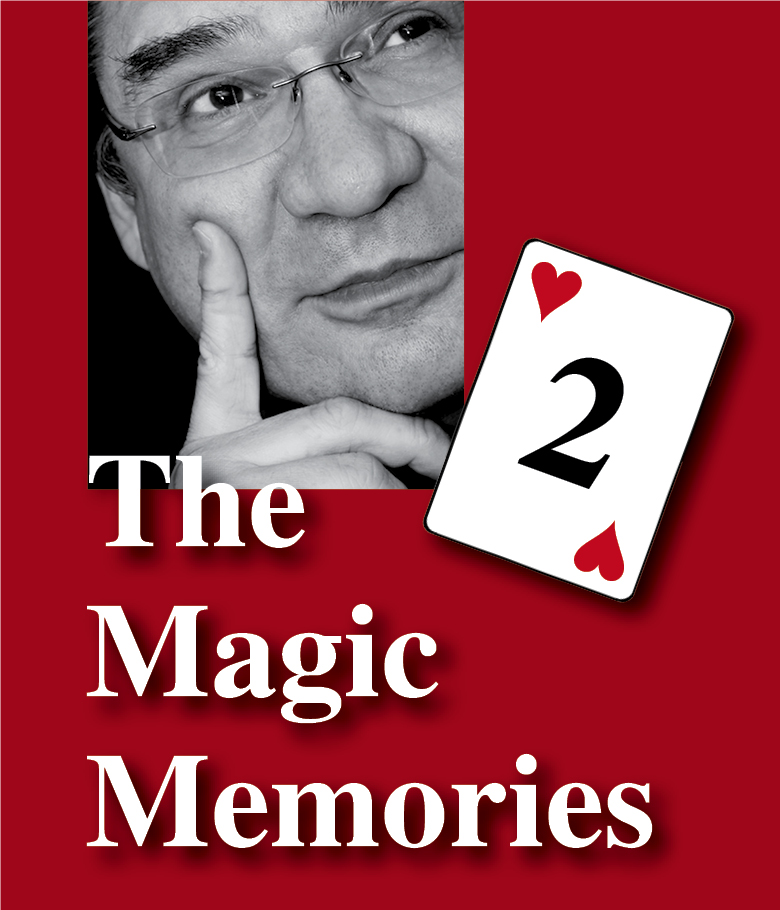
Hello everyone!
These are The Magic Memories 59, gone online Sunday, February 6th, 2022, at 0:07h sharp.

“Palindrome Cards” from Card College Volume 3
We’ve just finished taping all the technical part, as well as the performance and the explanations part of Card College 3 for the upcoming Card College 3&4 – Personal Instruction, the video-pendant to the book, similar to Card College 1&2 – Personal Instruction, which was the video interpretation of the volumes 1 and 2 of Card College.
There will be almost all the sleights from the book, plus 21 tricks to illustrate their use in a real-life performing situation. So, that’s plenty. Although the editing is still going on (a lot of work my friend Guillaume Cerati handles beautifully), I can tell you that this is going to be quite massive, and all for a very reasonable price, I promise.
You will be able to get the complete course, or just individual chapter-lessons, one of which I already know is one hour and twenty-two minutes long! That’s just the one Lesson 24 on “Assorted Techniques and Refinements”, mirroring Chapter 28 in Card College 3, and I plan to put this at your disposal at around $6. Agree? I hope to thus keep pirating to a minimum.
This week’s gift for you is a teaser from Lesson 28 on advanced multiple lift techniques, namely the “The Palindrome Cards”. If you have the book, you can find it in Card College Volume 3, p. 585. Notice the incredible coincidence: The trick starts on a palindromic page number, page 585! Can that really be a coincidence? As my friend Daryl used to say in his performances, “Is he man, is he beast!?”
“The Palindrome Card” is my elaboration and original interpretation of a much simpler idea by Verall Wass and Noel Stanton, two names you’ve likely never heard of. You can research them on Internet – entering their name along with “magic” in Google, for instance, will lead you to the respective archives, with further information.
There are several things which I find interesting about this trick.
First, it is exemplary for a trick that gains a lot through a proper presentational idea. The curious but otherwise meaningless effects are reframed and appear larger than life.
Second, it is definitively what Ascanio called a piece of “minor art”, i.e., it is neither a blockbuster nor a reputation maker, but still will reflect all you are in magic, because it requires the same attention as a larger piece. For once, I will “steal” my own text from Confidences (out of print), where I briefly discuss the subject as a preamble to a trick there called “Guaranteed!”:
Minor and Major Magic
A magic performance, whether formal or impromptu, when it is looked back on by you and your audience, is a complete experience. Although a detailed discussion of this issue would require a book in itself, the essence can be explained in a few sentences, with a succulent analogy:
A gourmet meal has several courses, maybe five to seven, even more if the portions are small. Of these, only two or three are major courses, such as one important starter, a main dish and a featured dessert. The remaining courses are conceived as appetizing transitions between the others and act as delicious “marriage brokers”. Such courses are the amuse-bouches, which tickle the palate at the beginning of the sensual journey: the soup, say, that allows the patron to move effortlessly from the fish and seafood to the plat de résistance, as the French colorfully call the main course. Then there is the sorbet, sometimes called un trou (a “hole”) by the French, a very small course, served after the main course or cheese board, which gives the mind and body a little rest, and seduces the customer to explore the dessert. And finally we come to the petits fours or friandises, fireworks of tiny sweets that accompany coffee and liquor, maybe even a cigar.
A magic performance—similar to a gourmet meal as an act of seduction and sharing—has a similar construction, although arguably with a greater artistic intention. There is a captivating opener, a smashing middle effect and a memorable finale. Between them are smaller pieces that consolidate the major effects, pieces that allow the performer and his audience to become acquainted and get personally closer. This makes the whole experience rich and pleasurable, a complete happening.
Neither in gastronomy nor in magic are these connective “minor works” treated as less important or done with less passion and talent than the “major works”. They are just not as complex, prominent and loud, but they are equally conducive to the magic atmosphere and experience. They require the same discriminate attention from the performer as do his other works. As Fernando Pessoa (1888–1935), the famous Portuguese poet, said, “The full moon is reflected in the large ocean, but also in the smallest puddle.”
Third, “The Palindrome Cards” is what we’d call a ” Packet Trick”, which is a genre of its own in card magic. Here I’ll refer you to the entry of DEC 27 in Hidden Agenda (also out of print) where I deal with the problem I believe most packet tricks suffer from. To save you the time to search for the book in your book shelf, here is the PDF of it – just one page – as a reminder (CLICK HERE). “The Palindrome Cards” is arguably the most elegant way to get around the question: “Why use a packet?”, as the cards are taken from the complete deck for a plausible reason, and at the end reintegrated into the balance of the deck. It’s a very nice excursion into the microcosm of the deck, if you will 🙂
This is performance only, and it is not yet the final version, which will have a still better resolution. However, it will give you an idea of the set, which we’ve kept on purpose to a minimums, as we did with Card College 1&2 – Personal Instruction. Remember that this is not a “show video” to show to friends, but part of a didactical video, it’s main purpose being to show how one or several sleights discussed in the preceding technical section are managed in a performance piece. You’ll notice an interesting phenomenon, though, namely that even with only two spectators you can still experience the timing, the misdirection and the typical reactions you would get from a lay audience. The lady on the right in the set is my wife Barbara, who knows everything, but still reacts as if she saw this for the first time, and the lady on the left is Astrid, a long-time friend of the family and who is a complete “muggle” reacting exactly according to script, with the difference that there is no script, her reactions being 100% authentic.
Anyway, I hope you enjoy this, and that it wetens your appetite for the complete project (scheduled for release end April 2022).
To see the preview of “The Palindrome Cards” CLICK HERE.
Next week we’ll continue the book list started in The Magic Memories 58.
All the very best!
Roberto Giobbi

